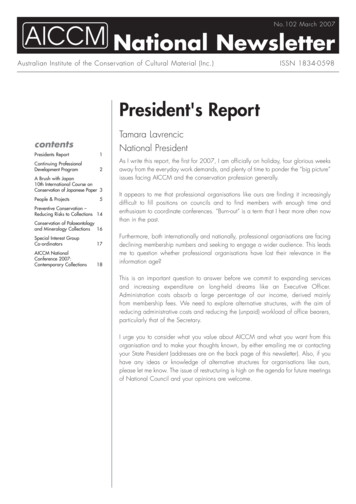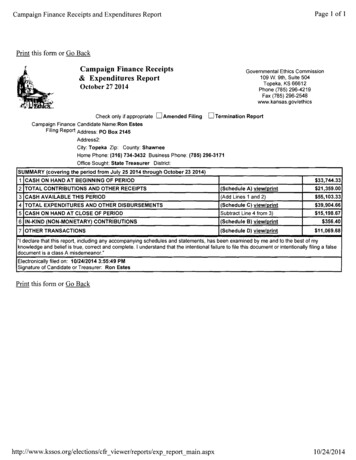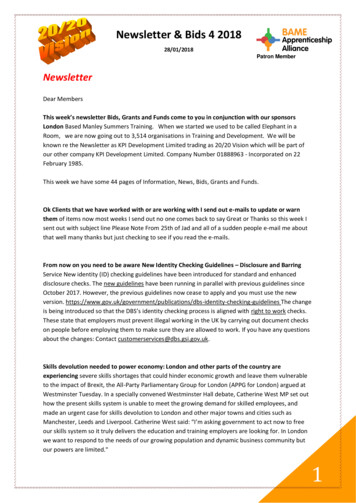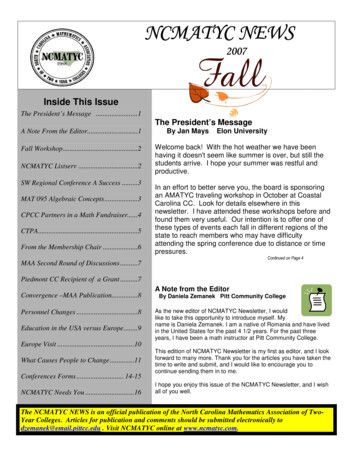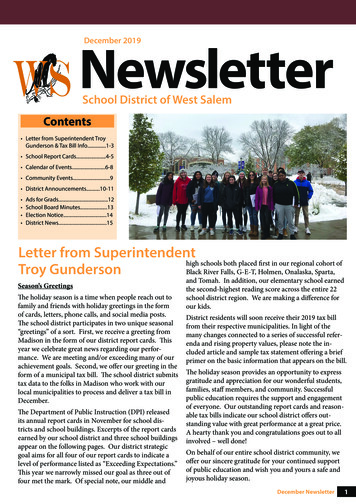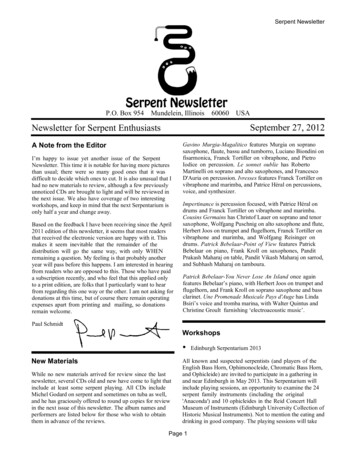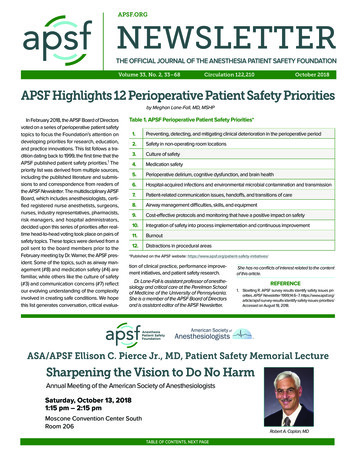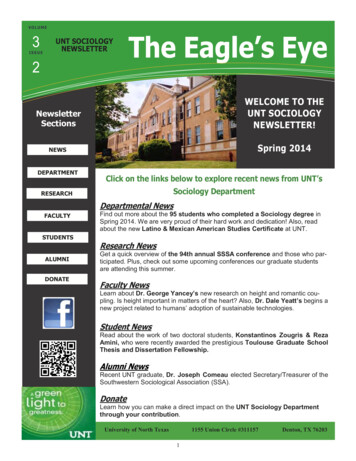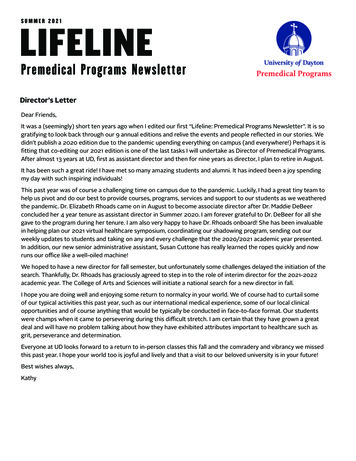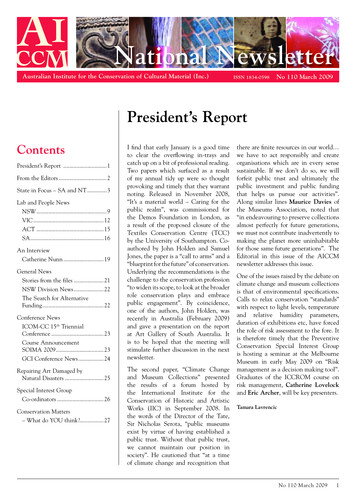
Transcription
National NewsletterAustralian Institute for the Conservationervation of Cultural Material (Inc.)ISSN 1834-0598No 110 March 2009President’s ReportContentsPresident’s Report .1From the Editors .2State in Focus – SA and NT .3Lab and People NewsNSW .9VIC .12ACT .15SA .16An InterviewCatherine Nunn .19General NewsStories from the files .21NSW Division News .22The Search for AlternativeFunding .22Conference NewsICOM-CC 15th TriennialConference .23Course AnnouncementSOIMA 2009 .23GCI Conference News .24Repairing Art Damaged byNatural Disasters .25Special Interest GroupCo-ordinators .26Conservation Matters– What do YOU think?.27I find that early January is a good timeto clear the overflowing in-trays andcatch up on a bit of professional reading.Two papers which surfaced as a resultof my annual tidy up were so thoughtprovoking and timely that they warrantnoting. Released in November 2008,“It’s a material world – Caring for thepublic realm”, was commissioned forthe Demos Foundation in London, asa result of the proposed closure of theTextiles Conservation Centre (TCC)by the University of Southampton. Coauthored by John Holden and SamuelJones, the paper is a “call to arms” and a“blueprint for the future” of conservation.Underlying the recommendations is thechallenge to the conservation profession“to widen its scope, to look at the broaderrole conservation plays and embracepublic engagement”. By coincidence,one of the authors, John Holden, wasrecently in Australia (February 2009)and gave a presentation on the reportat Art Gallery of South Australia. Itis to be hoped that the meeting willstimulate further discussion in the nextnewsletter.The second paper, “Climate Changeand Museum Collections” presentedthe results of a forum hosted bythe International Institute for theConservation of Historic and ArtisticWorks (IIC) in September 2008. Inthe words of the Director of the Tate,Sir Nicholas Serota, “public museumsexist by virtue of having established apublic trust. Without that public trust,we cannot maintain our position insociety”. He cautioned that “at a timeof climate change and recognition thatthere are finite resources in our world we have to act responsibly and createorganisations which are in every sensesustainable. If we don’t do so, we willforfeit public trust and ultimately thepublic investment and public fundingthat helps us pursue our activities”.Along similar lines Maurice Davies ofthe Museums Association, noted that“in endeavouring to preserve collectionsalmost perfectly for future generations,we must not contribute inadvertently tomaking the planet more uninhabitablefor those same future generations”. TheEditorial in this issue of the AICCMnewsletter addresses this issue.One of the issues raised by the debate onclimate change and museum collectionsis that of environmental specifications.Calls to relax conservation “standards”with respect to light levels, temperatureand relative humidity parameters,duration of exhibitions etc, have forcedthe role of risk assessment to the fore. Itis therefore timely that the PreventiveConservation Special Interest Groupis hosting a seminar at the MelbourneMuseum in early May 2009 on “Riskmanagement as a decision making tool”.Graduates of the ICCROM course onrisk management, Catherine Lovelockand Eric Archer, will be key presenters.Tamara LavrencicNo 110 March 20091
From The EditorsFrom The EditorsWell, it certainly is interesting times! Aswe read of how the way the world doesbusiness is going to change, we need tobe aware that this is bound to have animpact on the conservation profession.Specifically the private sector in whichalmost half of us are engaged are goingto see tougher times – unfortunatelya proportion of that work is seen asdiscretionary spending. Luckily theprivate museum is an unusual entityin Australia, unlike the USA wheremuseums funded by philanthropictrusts are doing it tough, resulting inpredictions of significant numbers ofmuseums closing.More broadly the cost of runningmuseums is going to be increasinglyscrutinised. That means energysavings are going to be looked for at alllevels from storage to administrationareas. This at least means that theenvironmental and ethical desirabilityof such will no longer be the onlyreasons to implement savings. Therecent ‘Climate Change and Museum2AICCM National NewsletterCollections’ forum, in London,reported on in the last edition of theAICCM newsletter (December 2009),highlighted the role conservators canplay in leading this debate. The in-depth interview withCatherine Nunn, paintingsconservator who is now inMelbourne after four years workingin the U.K.Much relevant work is already underwaywithin various state and nationalcollecting institutions, but there is agreat opportunity for the conservationprofession to step to the fore in Australia.We encourage all conservators to makethemselves familiar with the issues, andstart leading the debate. We plan todiscuss this in more detail in the Juneedition. More tales from the archivesfrom our investigative reporterextraordinaire, Ian Batterham.Meanwhile, in this edition, look outfor: The state profiles of SouthAustralia and the NorthernTerritory, as we continue ourstate by state focus on the localconservation activity. Next editionwe shall be focusing on Victoria andTasmania, with ACT to follow inthe September edition. Repairing art damaged by naturaldisasters – an interesting perspectivefrom main stream journalism at theWall Street Journal. A new topic under ‘ConservationMatters – what do YOU think’ – doread and comment back to us.We look forward as always to yourongoing support and input.Fiona Tennant and Julian Bickersteth
State in Focus – South Australia and the Northern TerritoryState in Focus – SA and NTIn focusing on the conservationprofession in South Australia andthe Northern Territory we wanted toemphasize the diversity and wide-rangingactivities undertaken by conservatorshere.In particular we want to show somethingof the many international projects andpartnerships undertaken by ArtlabAustralia and Fabric of Life in Adelaide,and the Museum and Art GalleryNorthern Territory in Darwin, and togive you an idea of the vibrancy andvitality our many visitors bring to thescene, whether they be students orinterns like Abby, Filipa and Song,interviewed below, or the pre-eminentscholar and lobbyist John Holden whorecently gave a presentation of his reportIt’s a material world, caring for the publicrealm to conservators and curators at theArt Gallery of South Australia.Let’s start with Jodie Proud, SeniorPaper Conservator at Artlab:In September 2008 Anne Dineen and Iwere invited to the National Archives inSingapore to deliver a workshop on stainreduction from paper items. The threeday workshop comprised of lectures inthe morning and practical treatments inthe afternoons with fifteen participantsfrom the Archives and Singapore’sConservation Centre. The week startedwith advice on preventative measuresand long term care of paper basedcollections. We thoroughly discussedmould prevention as the high humidityof the region is problematic to themuseum environment, and removalof mould stains from paper even moreso. Other types of stains discussed andtreated included tidelines and foxing,tape removal and tape stains.We found the approach to collectionscare quite different to our own previousexperiences. A few conservatortechnicians raised their concerns aboutpace and time and doing treatments enmasse efficiently. We observed that theremedy was to treat what was obviouslydamage first, without prior preparationor consideration for side affects. It leadus to discuss more thoroughly treatmentof a work from start to finish, includingspot testing, surface cleaning andbacking removals to minimize stainingand damage from solvent and aqueoustreatment used while removing stains.Working to a tight time schedule is adifficult challenge in all conservationfacilities, however the thorough careof the work is just as important andbecame some what of a mantra duringour practical sessions.The cultural experience was invaluable.The Singaporeans were very generousin their hospitality, ensuring Anneand I were comfortable, well fed andentertained for the week. We were ableto visit the newly furbished PeranakanMuseum and the Singapore ConservationCentre before celebrating our visit witha relaxing (but pricey!) Singapore Slingat the long bar in Raffles Hotel.Anne Dineen and students surface cleaning.Jodie Proud demonstrating stain reductiontreatments at the suction table.Mary Jose now runs Fabric Of Life, abusiness which has grown and developedout of her previous conservationonly business, Mary Jose TextileConservation:After working in conservation for nearly20 years I decided to expand my businessand indulge my love of textiles. I havecontinued to offer textile conservationservices to public and private clientsbut in addition to that I also sell andexhibit fine hand made textiles fromvarious parts of the world. Although wesell both old and new textiles our majorfocus is on fine quality hand made fairtrade textiles. Each year I travel to meetwith artisans and to select fine qualityhand made textiles to be used for interiordecoration or to wear.We hold exhibitions from time totime. There are a number of steamsto this and I will start with the closestto home. Since 2004 we have beenworking very closely with Ernabella ArtsInc particularly in relation to their batikwork. I phoned Ernabella and asked ifthey would like to work with me to holdan exhibition of batik scarves and RaikiWara (long cloth) for the AdelaideFringe Festival in 2004. The responsewas come up and visit and we’ll see ifwe like you. I travelled up to Ernabellaand spent a few days sleeping on the artcentre floor and met the artists and theco-ordinator at that time Hilary Furlong.I got the tick of approval and we heldour first exhibition together at Fabricof Life I February 2004. Since then wehave held may exhibitions together andalso a “tjanpi” basket making workshopwith three of Ernabella’s best fibre artistsitting under the trees in the AdelaideParklands. We have also sold work tomany Museum collections includingthe Art Gallery of South Australia,The National Gallery of Australia,the Powerhouse, The Queensland ArtGallery, the National Gallery of Victoriaand National Museums Scotland. TheNo 110 March 20093
State in Focus – South Australia and the Northern Territorysuccess of these exhibitions has helpedensure the ongoing creation of batik atErnabella.The other major stream is the collectionof textiles from India. I have travelledto India several times and developedrelationships with a number oftraditional artisans who excel in theproduction of their crafts. Some of theseartisans sell their work through NonGovernment Organisations and otherswork from their houses. Most of theseartisans are practicing skills which havebeen passed down through their familiesfor generations. They are embroiderers,tie dyers and weavers. My focus has beenon the textile arts of Gujarat, Rajasthanand West Bengal. In these areas artisansare producing work of exceptionally finequality that I have rarely seen in newwork. I hope that by promoting theirwork I will help in a small way withthe survival of these traditions. Theslow development of Fair Trade and theappreciation of traditional Indian textilesby the growing Indian middle classes arehelping to strengthen the appreciation ofthis work and increase the desire to helpit survive. We also stock textiles fromSouth East Asia, Africa, and CentralAsia.The combination of exhibiting textilesand providing conservation services hasmeant that I am able to advise clientsand how to best care for their textilesand also prepare works for display usingconservation practice. It has proved agood way of promoting the need forappropriate care of textiles to ensuretheir survival. We are also providing ashop front for customers to get adviceabout conservation of all materials andare able to refer people on to appropriatespecialist conservators.Kristin Philips, Head of TextilesConservation at Artlab, has also beenvery active in India and South EastAsia. Following on from workshops andconservation treatments carried outwith Renita Ryan at the SonobudoyoMuseum in Yogyakarta over the lasttwo years, and funded by the AustraliaIndonesia Institute, the Gordon Darling4AICCM National NewsletterFoundation and Asialink, Kristinhas recently conducted storage andconservation workshops at the MuseumBatik in Pekalongan, Indonesia, alsofunded by the AII, and more recently inGuwahati, Assam, India in conjunctionwith Vinod Daniel of the AustralianMuseum in Sydney.This was funded by AusHeritage with agrant from the Australia India Council.Kristin at the Batik MuseumKristin in IndiaAs we write, Kristin is back in Yogyakartacarrying out Counter-Disaster Planningworkshops with Joanna Barkman andSandra Yee of the Museum and ArtGallery Northern Territory.VickiHumphreyhasrecentlyreturned to South Australia after 51/2 years as Head of Conservation atthe British Library and has recentlybeen contracted to provide qualityassurance advice over a three yearperiod on the safety and preservationof the National Library of NewZealand’s Heritage Collections duringtheir building redevelopment andrelocation. (see ives/building-redevelopment) Vicki will alsobe travelling to the UK in Feb to attendmeetings of the ICON Accreditationcommittee and the ICON publicationscommittee – she remains a member ofboth of these committees. Vicki can becontacted by email on humphrey.vicki@googlemail.com.Sue Bassett, Senior Conservator atMAGNT gives us all the news fromDarwin and Dili: It’s been quite a whilesince Museum and Art Gallery NorthernTerritory (MAGNT) contributed to theAICCM Newsletter and if there has everbeen a time to make the assumption that‘no news is good news’, this is probablyit.The Materials Conservation Section ofMAGNT occupies a very compact labspace on the Fannie Bay beachfrontin Darwin, where the main institutionsits and virtually all of its collectionsare housed. Alice Springs’ Museumof Central Australia is also part ofMAGNT, and the broader umbrella ofMuseums and Art Galleries NT coversAlice’s Strehlow Research Centre andAraluen Cultural Centre too, but theDarwin facility has the only conservationlab and the only conservation staff inthe Northern Territory (the closestbeing Townsville and Adelaide). Theteam is part of MAGNT Research andCollections – along with CollectionsManagement, and History and Cultureand Natural Sciences branches – andhas responsibility for the care of thevery diverse art, craft, material culture,historical, archaeological and scientificcollections (including wet and drynatural history specimens). The teamalso provides support (predominantly inthe form of advice) to the communityand to the regions, as well as to otherdivisions within our NTG Departmentof Natural Resources, Environment, TheArts, and Sport, which includes the NTLibrary, NT Archives Service and NTHerbarium.The MAGNT conservation teamcomprises three permanent positions:the Senior Conservator (currentlyobjects/metals), and two Conservators(currently objects and paintings). Recentincidents and circumstances have led to
State in Focus – South Australia and the Northern Territorysignificant changes and developmentsat MAGNT such that we also currentlyhave a Temporary Conservator (paper/preventive), and may also soon recruitto a shared Technical Assistant position,making it the closest we have ever cometo having a full conservation skills set inthe Northern Territory. Hurrah!Past years have seen us all working asgeneralists and largely in a reactivecapacity, supporting a demanding andunrelenting in-house and travellingexhibitions program, assessing newacquisitions and preparing outwardloans, and keeping up as best we couldwith basic collection maintenance.Future scheduling and planning promisesnew opportunities and now includes avery welcome collection-based researchcomponent for conservators, withappropriate resource allocation and areview of staff numbers! More hurrah!Lisa Nolan, our paintings conservator(and our first ever specialist in thatfield), joined us at the end of 2007. Afterfinishing her current task of preparingthe outgoing paintings loans for 2009,Lisa will be the first to launch into amajor project. She will spend the next 12months or more exclusively conservingMAGNT’s very significant collectionof 225 early Papunya-Tula boards.Collected in the 1970s and mountedand framed in ways that seemed fine atthe time, this collection has remainedlargely untouched with much of itsidentifying labelling and informationobscured. It will benefit enormouslyfrom the systematic deframing andthe level of research, communityconsultation, documentation, analysis,stabilisation and professional attentionand consideration it is about to receive.The development of the Western DesertArt movement was sparked by theproduction of paintings on boards in theCentral Australian Papunya community,and MAGNT’s collection includes theearliest consignments of these boards. Byway of background to the project, a smallnumber of these works were conservedand were on display in MAGNT’sIndigenous Art Gallery when a break-in occurred in April 2008. Five werestolen and recovered a short time laterin nearby scrub, and the perpetrator wasapprehended and charged. The incidentresulted in Arts Minister Scrymgourannouncing special government fundingfor this extensive conservation andconsultation project, which is proposedto culminate in an international touringexhibition. Provision has also been madefor upgraded storage systems for futurehousing of the collection.Our temporary position was created as aresult of Lisa moving to this project, andis held by Tharron Bloomfield, paper/preventive conservator, who joined usfrom Canberra late last year. Tharronis clearing a backlog of paper-baseditems requiring treatment and, with hisextensive hands-on cyclone recoveryexperiences following Cyclone Heta inNiue, sharing his expertise on a rangeof issues related to disaster preparednessand management, as well as all thingspreventive. Tharron’s projects will alsoinclude an assessment and upgradeof storage of MAGNT’s secret/sacredholdings and development of an IPMplan for the NT Herbarium.MAGNT conservators were previouslyquite active throughout the NT,regularly presenting a variety ofworkshops for regional museums andcommunity groups, and running publicconservation clinics in most regionalcentres. This involvement has ceasedwhile the Regional Museums SupportOfficer position is temporarily vacant,but outreach programs have continuedwith a wider regional focus togetherwith MAGNT Curator of SoutheastAsian Art and Material Culture, JoannaBarrkman.Sandra Yee, our objects conservatorwho also takes responsibility for textiles,travelled to Dili with Joanna andanother MAGNT staff member last yearto borrow 47 objects from the nationalcollection of Timor-Leste for a jointexhibition with MAGNT in Darwin.They worked in collaboration with staffof the National Directorate of Culture(DNC), Democratic Republic of Timor-Leste, to design and construct crates andto clean and pack the loans for freighting.Delivered as on-the-job training for DNCstaff, there were clear benefits for bothorganisations – DNC staff worked witha conservator and display technician todevelop skills and sustainable collectionmanagement practices at their end, andMAGNT staff gained experience workingwith a very interesting collection whilebuilding professional capacity to workin Southeast Asia and in a cross-culturalcontext.The joint exhibition of Timor-Leste artand material culture, Husi Bei Ala TimorSira Nia Liman – From the Hands of OurAncestors, opened in November 2008 andwas the result of a long-term relationshipand very successful partnership betweenDNC and MAGNT. The relationshipgoes back to the early 1990s and, withUN, UNESCO and AusAID support,has involved salvage of the looted DiliMuseum collection by MAGNT staff in2000, and post-independence capacitybuilding assistance for DNC in theform of staff seminars and the provisionof intensive Darwin-based training ofpersonnel in museum development,procedures and practices. The MAGNTconservation team contributed to thistraining which, together with theresultant exhibition, has had positiveoutcomes for preservation of the culturalheritage and identity of Timor-Leste, andto nation-building. The documentation,treatment, preservation and publicationof a significant component of thenational collection of Timor-Leste hasbeen realised and, on its return to Dili,this material will form the basis of thedeveloping National Museum of TimorLeste.Sandra’s other overseas activitiesinclude delivery of a training program inIndonesia in January and February 2009,together with Artlab. The two-weekworkshop is funded by the AustralianInternationalCulturalCouncil,Department of Foreign Affairs andTrade. It is being delivered to membersof the Yogyakarta Museum Associationand staff of the Gadjah Mada UniversityNo 110 March 20095
State in Focus – South Australia and the Northern Territoryat the Sonobudoyo Museum, Yogyakarta,and will cover museum disasterpreparedness and relevant aspects ofcollections management.Sandra also proposes to travel to Diliin late March 2009 to provide practicaltraining to Timor Aid and the AlolaFoundation on care and managementof textiles, and to design and implementstorage systems appropriate to localconditions and resources.Lisa and Sandra are also in the processof developing a collaborative researchproject with Joanna Barrkman toinvestigate natural dyes and theirapplication to handwoven textiles inIndonesia and Timor-Leste. The pilotproject will commence in March 2009and involve travel to West Timor todocument mud and indigo dyeingtechniques with the Yayasan Tafean Pahweaving cooperative.Sue Bassett is the Senior Conservator(objects/metals). Sue is in the final stagesof preparing a Disaster Management Planfor MAGNT, and has been stabilising avariety of objects (metal, wood, ceramic)recovered during dredging for theDarwin waterfront development. Shealso recently assisted the Department ofthe Chief Minister by coordinating thedisplay of the painting Earth’s Creationby Utopia artist, the late Emily KameKngwarreye, in Darwin’s ParliamentHouse. Earth’s Creation, comprising fourpanels totalling 6.3 x 2.7 metres, waspart of an NMA exhibition of works byEmily Kame Kngwarreye that travelledrecently to Japan.Some of the big challenges in recent yearshave centred around the managementof a very heavy workload, overflowingstorage areas, and an old and unreliableair-conditioning system. Managingrisk associated with the servicing,flushing and upgrade of the old wet-pipesprinkler system and a major carpetbeetle infestation were up there too, asis preserving our maritime collection ofdeteriorating historic vessels displayedfully rigged in an uncontrolled tropicalenvironment just metres from the sea.6AICCM National NewsletterAnd each year between December andMay there’s that ever-present threat ofa destructive cyclone. But most of theseissues have been resolved or are beingaddressed, systems are being upgradedand improved, outcomes are positive,opportunities lie ahead, and high-levelstrategic planning for the future of theNT museums sector is underway.All news is good news!Back at Artlab we spoke to interns,Abby, Filipa and Song:Volunteers and interns constantly flowthrough the different specialty areasof Artlab. They carry out invaluablework, research, and are often able tobenefit by broadening their skills andexposure to various types of objects.Three conservators who have recentlyspent time at Artlab were interviewedto help us learn a little bit more aboutwhat motivates this vibrant section ofthe Artlab workforce.Abby Maxwell-Bowen completed afour week mid-career placement in theObjects lab during December 2008. Thisis her second trip to Australia.Abby’s conservation training andbackgroundAbby originally trained in conservationthrough an apprenticeship in the UK.She remained with the London basedprivate conservation company whereshe completed her apprenticeship andhas been working there for 17 years.The company Abby works for takes onall types of work and Abby has vastexperience working on outdoormonument and sculptures. Abbydescribed her work as being 60:40%conservation: restoration.Why did Abby come to Australia andmore specifically, Adelaide?For Abby the main attraction in Australiawas Artlab. After unsuccessfully applyingfor a bursary, Abby moved home andlived with her mum so she could savethe necessary funds to fund her time inAustralia. It is clear that she was verydedicated to the idea of coming here!Abby has always been interested inworking with ethno graphic collectionsand felt that the best place to get thatexperience was in a country that hadits own Indigenous population. Thedialogue which surrounds conservationand treatment of ethnographic objectshas long fascinated Abby. She also feltthat it was difficult to work between thestrictly defined conservation disciplinesin the UK.An outline of the treatment Abbyenjoyed most while working at ArtlabAbby most enjoyed working on acollection of seven Papua New Guineancostumes. The Asmat costumes had allbeen made by men and worn duringmortuary feast celebrations. Theconstruction techniques are consideredsecret, which raised the issue of whetherAbby should be working on the costumesat all. After discussions with the curatorwhich resolved these issues, Abby deviseda method of approach which took intoaccount the brief and resources of theclient, and the time she had available.She assessed the object in terms of itsrequirements for storage and display.Working on the textile’s ‘knitted’ surfacewas unlike any other experience she hadhad in England.What is Abby doing with theremainder of her time in Australia?Apart from taking out a year-long gymmembership, Abby plans to travel andwork voluntarily in Sydney, Melbourne,Perth, Auckland, possibly Wellington,and then return to Artlab. Her ultimateobjective is securing paid conservationwork in Australia.What did Abby like about being inAustralia?The attractions of Australian life arehuge for Abby and mostly come underthe heading ‘lifestyle’. Not having tocommute 2 hours twice a day to her workplace rated very highly with Abby, as didour abundance of sunlight, space, highquality affordable food, and the genuine
State in Focus – South Australia and the Northern Territorypeople she has met. Professionally Abbyhas been excited to go to work every dayin Australia; the experience has reignitedher passion for working in conservation.Abbyworkingon wovenceremonialcostumeFilipa Quintela has been workingfor nearly one year as a volunteer inthe Objets lab at Artlab, she has alsoundertaken some paid work with theProjects team.Filipa’s conservation training andbackgroundFilipa completed an undergraduatedegree in conservation in Portugal in2007. A nine month internship formedpart of her course work, Filipa completedthis with a furniture conservator/restorer.Filipa has continued to expand herskills while volunteering at Artlabundertaking a diverse range of jobs suchas: repairing ceramics, box making, afurniture cleaning treatment, polishingchrome at the National Motor Museum,working on ethnographic plant fibreobjects, cleaning accretions of anintricately carved door, and workingon ships models. Some of the paid workFilipa has undertaken with the Projectsteam includes waxing and patinatinglarge bronzes, and working on stonemonuments.Why did Filipa come to Australia andmore specifically, Adelaide?Filipa originally came to Australia for aholiday. Whilst still in Portugal Filipalooked at the Artlab website and feltthat the company adhered to the sameprincipals as she was taught in Portugal.So Filipa contacted Artlab and organisedto visit us while in Australia. The workthat was immediately available inPortugal was more ‘restoration’ than‘conservation’ and Filipa wanted to focuson developing her conservation skills.Filipa emphasised that conservationpractice in Portugal is not generally‘restoration’ based. In fact they have thesame principals as Australia. Filipa endedup staying in Adelaide, and eventuallymarried here. Filipa and her partner planto stay here for a few years.An outline of the treatment Filipaenjoyed most while working at ArtlabA treatment Filipa enjoyed and feltshe learnt a great deal from was theconservation of a woven plant fibre hat.There were many elements in the openstyle of the weaving that had snapped andcompromised the shape and structuralintegrity of the form. Filipa spent manyhours fixing fine strips of dyed Tyvek inplace with Beva film.What is Filipa doing with theremainder of her time in Australia?Filipa plans to continue to volunteerat Artlab, with a view to getting morepaid work here. Although this is asomewhat tenuous situation to be in, shesays that her Portuguese colleagues arealso experiencing difficulties securingwork. Volunteering is a really goodway for Filipa to keep her hand skillshighly tuned, and stay in touch with theprofession.What does Filipa like about being inAustralia?The quality of life is much better inAustralia than Portugal according toFilipa; there are many more opportunitiesto work and live the way you want,not to mention better pay conditions.Filipa has loved
the Northern Territory we wanted to emphasize the diversity and wide-ranging activities undertaken by conservators here. In particular we want to show something of the many international projects and partnerships undertaken by Artlab Australia and Fabric of Life in Adelaide, and the Museum and Art Gallery Northern Territory in Darwin, and to
